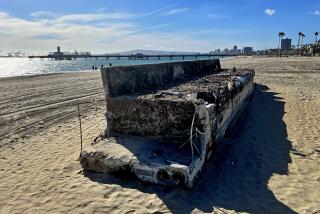This stacks up as art -- with a functional side too
- Share via
Reporting from Vancouver, Canada — In these overly processed, corporate-sniffing Olympics, in a Winter Games where everything often seems pre-scripted and homogenized for TV -- even the snowboarding wipeouts -- Zdzislaw “Ziggy” Groszek stands out.
On his own, one rock at a time, Ziggy has turned a local beach into an art installation that is as dazzling as any laser show or musical performance the Olympics has to offer.
As thousands of fans line up to see Leonardo da Vinci sketches two miles away, Ziggy’s artwork -- if you want to call it artwork; I will -- stands as a totem to what one individual can do, given a little inspiration, a lot of patience and a keen eye for physics. It is a spontaneous and heartfelt civic gesture that is charming visitors and locals alike.
Cost: free. Wait time: zero.
Charles Kuralt made a career of guys like this, the stubborn stoic, toiling at something that burnishes the soul. Here’s how it happened with Ziggy:
The unemployed maintenance man was walking along a local inlet one day, past a quarter-mile of beach brimming with riprap and rounded granite. His adopted city, Vancouver, was glowing like a prom date with Olympic preparation. All around town, sidewalks were being scrubbed -- they pressure-wash the sea walls here, even in the rain -- and the city was being wrapped in a mink of Visa ads and McDonald’s logos (don’t get me started).
With his recent layoff, Ziggy had nothing but time, so he grabbed some of the fist-size granite and started doing what comes naturally to him, that thing he missed most while jobless: working with his hands.
The Polish immigrant was doing what the Inuit called “Inukshuk,” stacking of rocks. Sometimes they take human form. Other times, they look like abstract art, teetering, small rocks supporting bigger rocks, an engineering lesson in weight-to-ratio distribution.
They seem, at first glance, just impossible.
You think there must be mortar in there somewhere, or at least a little wad of chewing gum. No. Just naked rock on naked rock, granite against granite against granite.
Ziggy was patient but methodical. For three days he worked, and before he knew it he had a garden of the things, hundreds, maybe thousands. You see the Inukshuk along the coastline here, but never like this, usually just one here, then a mile later, maybe another one.
Before he knew it, Ziggy had his Stonehenge.
“It is one of the nicest things in the Olympics,” says visitor Shiloh Belliveau, kneeling to snap just the right picture. “It’s just one of those amazing random acts.”
The history of such rock work indicates it was often more about function that aesthetic. Belliveau explains how the people of the Arctic used them to help herd caribou, stacking them in human form, like scarecrows, to fool the valuable food source into cooperating.
The rock stacks also served as signposts, experts say, for travelers in desolate stretches of the far north, occasionally marking stashes of food in the harsh terrain. They were symbolic of an unselfish people, they say.
Often, they were 20 feet tall and required the work of many men. You still see cultural monuments like this, along the sea wall at English Bay here in town, or up at Whistler. Pronounced in-NOOK-shuck, the word translates roughly into “the image of man.”
Now all that tradition and culture symbolism has found its way into the hands of a Polish immigrant who just wanted to make a stretch of urban beach look a little better.
It can take him just minutes to stack four or five of the stones, but he never rushes. “Everybody says it’s so hard,” he explains in a thick accent. “But I say take your time.
“There are no secrets. Everything is balance.”
What he has created has charmed passers-by on the way from the nearby hockey pavilion to the Russian pavilion a mile away. It is a busy stretch, and they stop for thousands of pictures. Local TV crews have also spotted Ziggy’s growing garden, and they stop briefly to chat with the gloved worker, in conversations that are mostly shrugs and modesty.
“I knew the tourists were coming,” he tells them, “and I thought I’d do a little something to make it look nice.”
What he has wrought is the most unusual art installation you will ever see -- no publicists, no websites, no artist attitude.
Just Ziggy Groszek, one rock at a time, hour after hour after hour.
More to Read
The biggest entertainment stories
Get our big stories about Hollywood, film, television, music, arts, culture and more right in your inbox as soon as they publish.
You may occasionally receive promotional content from the Los Angeles Times.











